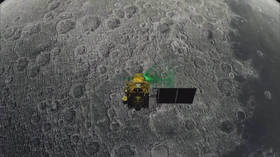India’s Chandrayaan-3 mission lands on Moon

The lander module from India’s Chandrayaan-3 mission successfully touched down on the surface of the Moon on Wednesday.
The Indian Space Research Organisation (ISRO) and Indians across the globe celebrated the achievement, which makes India the fourth nation to successfully land a spacecraft on the Moon, after the Soviet Union, the US, and China. The event was live streamed by the ISRO on its YouTube channel.
Prime Minister Narendra Modi watched the landing from South Africa, where he is attending the BRICS summit. “We have seen history being made, and this makes our life worth it. This is the beginning of a developed and ‘New India,’” he told ISRO scientists. He added that the success belonged to all humanity.
Uniquely, the Chandrayaan-3 mission is the first in history to land near the lunar south pole. For the lander module to touch down, the ISRO activated an automatic sequence, triggering an algorithm that took over once the spacecraft was in position above the designated landing zone, and then guiding it to the lunar surface.
The Chandrayaan-3 lander is around 2 meters tall and has a mass of just over 1,700kg. The lander and the rover together have six payloads with which to study the lunar south pole, a region that bearing ice, which, according to scientists, could be a source of oxygen, fuel, and water for future Moon missions.
On August 18, the ISRO achieved a significant milestone by successfully executing its inaugural de-boosting operation, resulting in a reduction of orbit to 113km x 157km. This operation took place one day after the separation of the lander module from the propulsion module. The separation marked the conclusion of a 34-day expedition to the Moon. Following this, on August 20, the ISRO conducted the concluding phase of deboosting for the lander module, adjusting its orbit to 25km x 134km.
Chandrayaan-3 Mission:'India🇮🇳,I reached my destinationand you too!': Chandrayaan-3Chandrayaan-3 has successfullysoft-landed on the moon 🌖!.Congratulations, India🇮🇳!#Chandrayaan_3#Ch3
— ISRO (@isro) August 23, 2023
Anticipation and excitement gripped India in the days before the landing, with temples, mosques, and churches reverberating with prayers, while schools, community centers, and India’s diplomatic missions abroad invited people to witness the landing through live telecasts.
India’s ascent as a significant space player comes before next year’s national elections. The government led by Prime Minister Narendra Modi is focusing on stimulating investment in the space sector, particularly for satellite launches. Modi emphasized during the launch of the Moon mission that the ISRO was writing “a new chapter in India’s space odyssey,” thereby uplifting “the aspirations and ambitions of every Indian.”
ISRO chief S. Somanath congratulated his team on the success of the Chandrayaan-3 mission, saying “We learned a lot from our failure and today we succeeded.” The words evoked memories of the heartbreaking moment nearly four years ago, when former ISRO chief, K. Sivan, cried on the prime minister’s shoulder after the Chandrayaan-2 mission crash-landed on the Moon. On Wednesday, after Chandrayaan-3 had landed safely, K. Sivan told ANI news agency “We are really excited to see the grand success. The nation was waiting for this moment.”
From K Sivan sobbing on the PM's shoulder to the entire country erupting in celebration, India's moon journey has been astounding. In true scientific spirit - we failed, tried again, and succeeded. Congratulations to Team @ISRO, and everyone involved with #Chandrayaan3! 🇮🇳🚀 pic.twitter.com/nuwK36kEXk
— Hardik Rajgor (@Hardism) August 23, 2023
Messages poured in from all corners of the world, underscoring this precious moment for India. “Congratulations to India on being the 4th country to successfully soft-land a spacecraft on the Moon. We’re glad to be your partner on this mission,” NASA Administrator Bill Nelson wrote on X (formerly Twitter).
Russian Ambassador to India Denis Alipov wrote: “Humanity’s quest for space exploration takes a monumental leap forward. Kudos to the brilliant minds behind this remarkable feat!”
Mallika Sarabhai, daughter of ISRO founder Vikram Sarabhai, after whom India’s moon lander was named, told News 18 broadcaster she was thankful to ISRO scientists “who have kept Papa’s dream alive and who have brought us here today.” “I feel somewhat concerned that this can become a race, a race to prove how great we are. That’s not what this is about, this has to be about how we can empower humanity, how we can use science to take away some of the many ills that divide our world,” she said.
Two hours after the landing, ISRO released images of the Moon taken by the Lander Horizontal Velocity Camera of Chandrayaan-3 during the descent. The space agency said a communication link had been established between the lander and the mission operations complex in Bengaluru, the capital of India’s southern Karnataka state.












